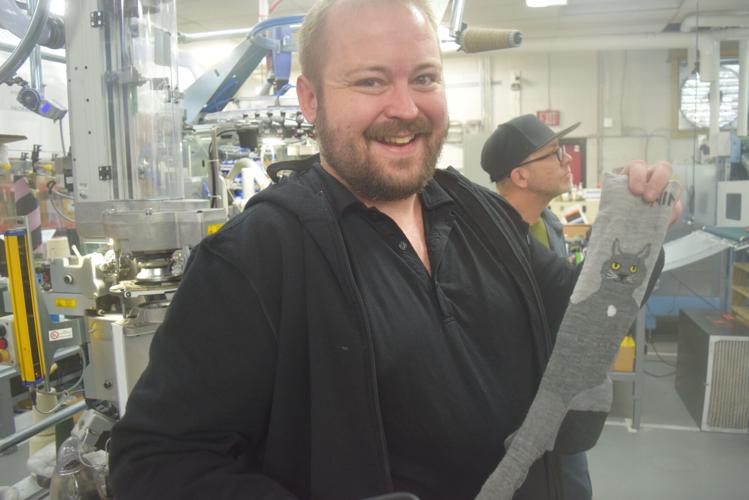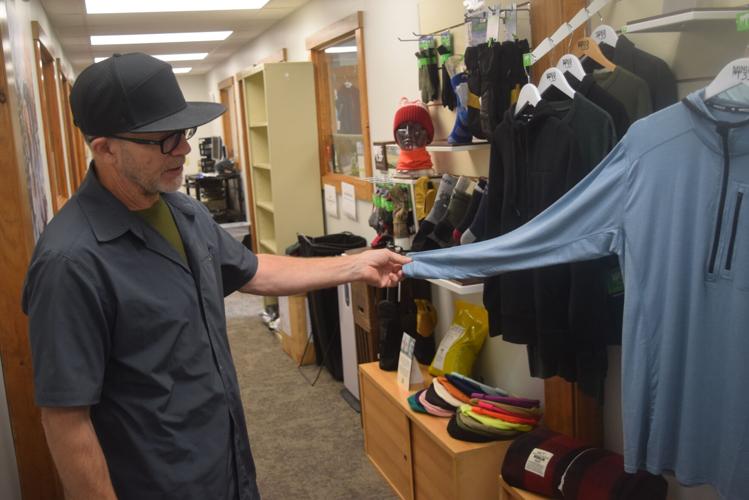One of the most commonly asked questions at the Mount Washington Observatory is the history of the cats who live at the summit. Now, the observatory has partnered with Ashland-based Minus 33 to create socks to benefit the nonprofit while honoring the current cat-in-residence, Nimbus.
“There have been felines at living at the summit of Mount Washington since 1932, and Nimbus joined in April 2021,” observatory Communications Manager Ellen Estabrook said of the great shorthair cat from the Conway Area Humane Society. “This celebrates our beloved mascot, because he is a popular fixture up there."
Estabrook said the Minus 33 team came up with the collaboration idea, to sell comfortable, sturdy socks with an image of Nimbus. Thirty-three percent of the proceeds benefit the observatory to directly fund research and weather forecasting on the tallest peak in the Northeast.
“We are super excited about this partnership and new collaboration,” Estabrook said. “It aligns with our mission.”
Minus 33 Director of Marketing Mike Bednaz said the company has a 109-year-old history, dating back to 1916, when Ashland was a textile town. It was all hydro-powered mills, and what was then known as L.W. Packard was the largest wool producer in the country.
“We were making woolen-length full rolls of wool for the Brooks Brothers and LL Beans of the world,” Bednaz said.
The company is in its fifth generation of leadership, with Lawson Glidden as company president. Minus 33 started in 2002, under the umbrella of parent company L.W. Packard.
“My family started the L.W. Packard mill back in 1916, and we made wool cloth for basically every company in 2000, when we shut down the main manufacturing portion,” he said. “Then we started Minus 33, and that ran before 15 years before I came in.”
Minus 33 staff have been using sock machines onsite since 2018, and just started with new hat machines, making most manufacturing for wool socks and hats domestic.
There are two textile engineers in house, who make a wide range of 100% Merino wool products, as well as some with blends. Bednaz said the products are certified to be free from microplastics. All wool comes from Australian farms certified to be humane, and for purity.
The company produces a variety of items, including lightweight base layers, and also the 100% Merino products Bednaz calls the company’s bread and butter. They make blankets, shirts, headwear, gloves, and of course, socks.
“The socks are pretty much our superpower here,” Bednaz said. “We make them right in the back. It’s a high percentage Merino wool content. They are engineered to fit your foot for no slippage. When you get slippage, you get the blisters.”
He explained the wool they use is anti-bacterial, and now used in a new line of heavy-duty gloves. If items come back to them with small damages, or if items they make don’t make the cut for quality, they are repaired and sent out to search and rescue groups around the country.
“This is so they can grab and go in case of a back country emergency,” he said. “Right here in the White Mountains they are used a lot. It’s a good sustainability practice, too.”
The company makes expedition weight socks for extreme cold environments, which is what weather observers on Mount Washington wear.
“A lot of this heavyweight stuff, we send this up to the weather observers to go out every hour and take their measurements on New England’s highest peak,” Bednaz said.
The first sock they created in partnership with the observatory is “summit sock,” sold at year-end. Estabook said Minus 33 has also been selling the summit sock, the official hiking sock of the Mount Washington Observatory, online for the past couple years.
As for the nimbus sock, it's made at the factory in Ashland. Glidden demonstrated how the yarn goes through a cylinder with 168 needles, spinning in a circle at 200 rotations per minute. Each time they spin, the needles make a tiny stitch. The machine finishes everything up to the toe seam, so no stitching is done by hand. The patterns for the nimbus socks are all drawn by Glidden.
Glidden underscored how important it is to have a quality sock, something many people don’t understand. Every time you take a step, all your bodyweight goes through the sock. Merino wool is “a super fiber,” both anti-microbial and thermal-regulating.
“If you’re cold, it has air pockets to warm you up if you get it wet,” Glidden said. “It is one of the only fabrics that can warm you up while you’re wet. It is also fire-resistant and won’t melt if it catches fire. We’ve been using it as humanity for 10,000 years, and those sheep were evolving for millions of years before that. I feel like we have cheated the system. Everyone wants to melt plastic and make a super fiber, but it is just right there on the sheep for us.”
The clothing company creates apparel for the observatory designed for the harshest of conditions, which are worn and tested by staff living and working at the summit.
“There are fantastic hats, liners and gloves sent up to the summit staff,” Estabook said. “It’s exciting to receive those Merino wool items.”
The staff at the summit operates on a “week on, week off” shift schedule, so there is someone always collecting data. The winter months have some of the most extreme weather conditions in the world. Estabrook said there are record numbers in temperature and wind chill.
On Feb. 4, 2023, the lowest air temperature captured there was recorded at -47 degrees Fahrenheit, which tied the observatory's own record, set in 1934. The wind chill was recorded at -108 degrees, an amazing number Estabrook said made her do a double-take.
“The gear they provide is crucial in those kinds of conditions,” Estabrook said.
Estabrook said there are typically two-daytime observers, a nighttime observer and two winter interns. Often the interns become weather observers, after enjoying the unique experience of spending a season on the summit as the only human inhabitants aside from the New Hampshire state park staff.
“The weather observers love it up there, because it’s a place where weather systems come to them,” Estabrook said. “They can step outside and feel it.”
Nimbus, named after the gray clouds that look like his fur, is the observatory’s unofficial mascot and only full-time resident on the mountain. Each sock has his face on the side.
The limited-edition socks have been sold since Sept. 15, and can be found at Minus33.com.




















(0) comments
Welcome to the discussion.
Log In
Keep it Clean. Please avoid obscene, vulgar, lewd, racist or sexually-oriented language.
PLEASE TURN OFF YOUR CAPS LOCK.
Don't Threaten. Threats of harming another person will not be tolerated.
Be Truthful. Don't knowingly lie about anyone or anything.
Be Nice. No racism, sexism or any sort of -ism that is degrading to another person.
Be Proactive. Use the 'Report' link on each comment to let us know of abusive posts.
Share with Us. We'd love to hear eyewitness accounts, the history behind an article.